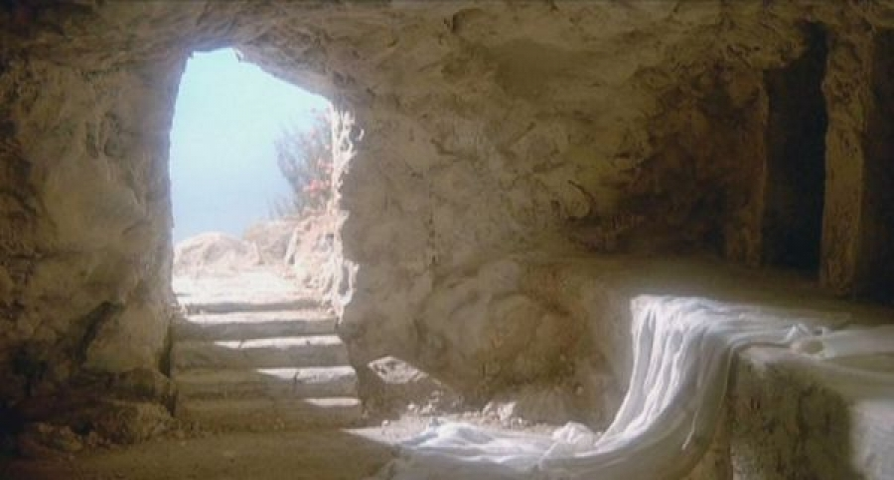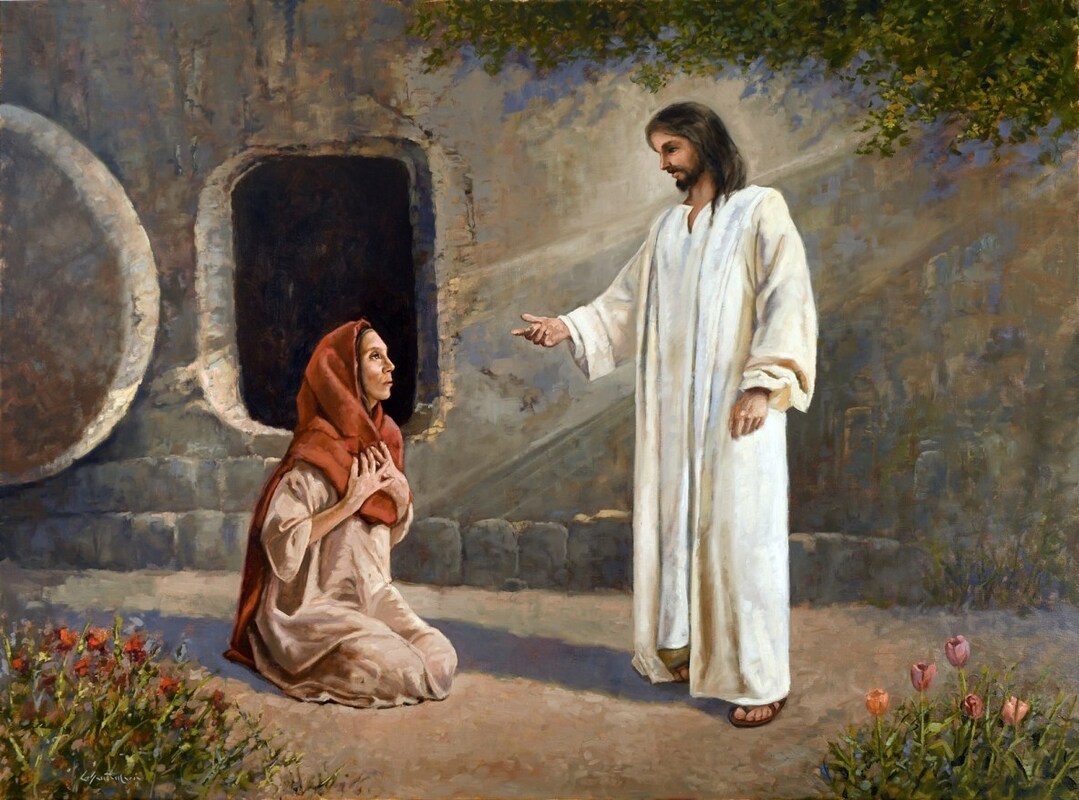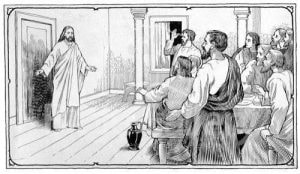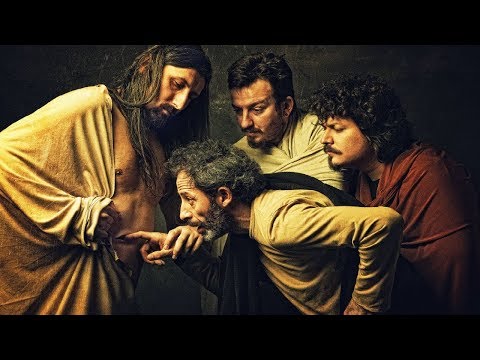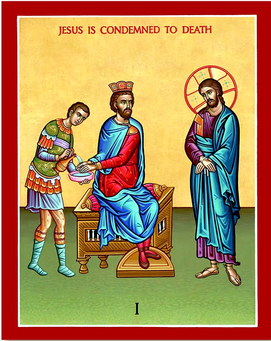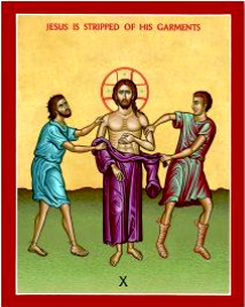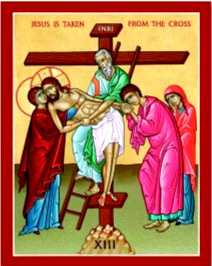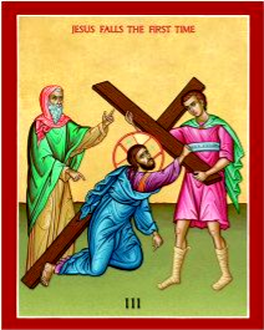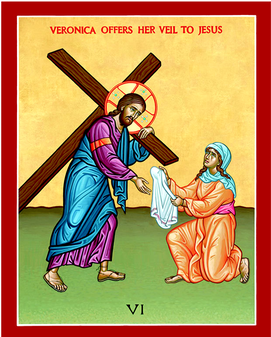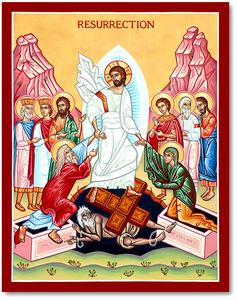Answers to questions should be emailed to:
[email protected]
in the subject line:
Student's First & Last Name
& Assignment #
Las respuestas a las preguntas deben enviarse por correo electrónico a:
[email protected]
en la línea de asunto: Nombre del estudiante y Apellido
May 28, 2020
Dear All,
Once you have completed the part about St. John Bosco, you have completed the whole RE school year 2019-2020. Congratulations!
Check back next week. By then all your assignments will have been reviewed. If there is anything missing or incorrect, you will have to correct it in order to complete the year.
Below you will find the information about St. John Bosco.
elementary school:
watch the video about St. John Bosco.
Assignment: Review the list of the Corporal and the Spiritual Works of Mercy. Write the names of at least three types of works of mercy that St. John Bosco performed.
teens:
Please read the brief life story of St. John Bosco. Answer the questions in the text.
Once you have completed the part about St. John Bosco, you have completed the whole RE school year 2019-2020. Congratulations!
Check back next week. By then all your assignments will have been reviewed. If there is anything missing or incorrect, you will have to correct it in order to complete the year.
Below you will find the information about St. John Bosco.
elementary school:
watch the video about St. John Bosco.
Assignment: Review the list of the Corporal and the Spiritual Works of Mercy. Write the names of at least three types of works of mercy that St. John Bosco performed.
teens:
Please read the brief life story of St. John Bosco. Answer the questions in the text.
St. John Bosco
Be cheerful, do good, and let the sparrows chirp.
What do you think it means?
Giovanni Bosco lived in the 19th century. He was born into a very poor family in northern Italy. Giovanni craved to learn and this caused serious hostility from one of his older brothers. His life in the family home became so unbearable that he had to leave it at the age of 12. He found kind and supportive adults and, against all odds, finished his education all the way through college. He became a priest and started serving in different parishes. In his native Italian people addressed him as a priest: “Don Bosco” and this is how the rest of the world calls him today.
Whatever you accomplished in life, you could not have done it without support from kind people.
Who are they? Take a minute to bless them.
The 19th century in the Western world means wild industrialization with savage exploitation of workers. Time comp, unions, pensions, insurance etc., still belong to the realm of science fiction. Parents work from sunrise to sunset, public schooling is not available yet, so teenagers roam streets all day – looking for work or looking for trouble. Don Bosco starts to reach out to teenage boys around his parish. He plays soccer with them, tells them stories, and listens to them. They sing and laugh together. And… what do you know – his parishioners take offence. He is supposed to sit in church and pray. He is supposed to spend time with them – the adults. They start a slander campaign against him. Yet, some people admire his ministry. One family donates him a house where Don Bosco can move his ever-growing group of teens. Soon enough neighbors start a campaign against it – too much noise and too many scary kids around the neighborhood. The pattern of moving from house to house chased away by good people who hate the noise repeats itself a number of times. Finally, Don Bosco moves into a bigger house outside the city. By now, there are already a few hundred boys in his ministry. He teaches them the 3Rs and religion. He looks for work for them. He demands from employers to promise him not to beat the boys they take as workers.
Some of the boys steal from Don Bosco’s house, from his parishioners, or from their employers. Some start fights. Some are rude and demanding. Some priests portray Don Bosco to the bishop as a madman or as a heretic who takes kids out of churches. The bishop reprimands Don Bosco severely without bothering to investigate on site. Local politicians fear Communist revolution and suspect Don Bosco of political ambitions as a worker leader. There are a few assassination attempts on Don Bosco.
Which part of Don Bosco’s cuddly youth ministry would you consider as less nice? If you lived in Turin at that time, would you support or oppose Don Bosco? Did you say: “Support”? Oh, come on. You are kidding yourself.
Finally, Don Bosco gets very sick. The stress takes its toll. He lands up in a hospital. The boys are very distressed but they are not allowed to come and see him. Hundreds of them stand on the street looking at his hospital window and wave. They organize themselves into orderly groups. They take turns in twos to come and visit him. The whole neighborhood – first terrified at the sight of hundreds of “hooligans” – comes to admire their discipline and love for Don Bosco. People discover how different these boys are from their countless unmannered and neglected peers around the city. Politicians who rack their brains how to address the teenage homelessness and vandalism in the city see the light at the end of the tunnel. Even anti-church decision-makers recognize value in Don Bosco’s work.
What does Jesus mean when he says: “By their fruit you will recognize them?” (Mt 7:16) What fruit did people in Turin notice?
What fruit can people notice in you? Do you know the fruits of the Spirit by heart? Google them.
How can we prevent burn-out in our ministries? Don Bosco recovers. His mother moves from the countryside to his house in Turin. She cooks and cleans for him. Young adult men join him and become leaders of boys. Maria Mazzarello and a group of women start a ministry for girls. Married people support both ministries by becoming volunteers or even members of Don Bosco’s religious organization. Soon the groups develop into Salesian Fathers, Salesian Sisters, and Salesian Cooperators. The Queen of England hears of this successful way of addressing marauding teenagers in industrialized cities and sends her representatives to learn more. The king of Italy follows suit (and he should have been first to do it, right?). Soon Don Bosco receives wide support from people inside and outside the Church.
Today the Salesian Fathers is the biggest Catholic male religious order in the world. There are a number of female communities who serve young people following Don Bosco’s spirituality. Think of the millions of teenagers in many countries being helped by men and women who chose to give their lives for young people instead of pursuing their own careers, getting married, buying a nice house with a pool, etc.
What do you tell God after learning more about Don Bosco?
What do you think of Don Bosco’s advice to others:
“Be cheerful, do good, and let the sparrows chirp.”?
Be cheerful, do good, and let the sparrows chirp.
What do you think it means?
Giovanni Bosco lived in the 19th century. He was born into a very poor family in northern Italy. Giovanni craved to learn and this caused serious hostility from one of his older brothers. His life in the family home became so unbearable that he had to leave it at the age of 12. He found kind and supportive adults and, against all odds, finished his education all the way through college. He became a priest and started serving in different parishes. In his native Italian people addressed him as a priest: “Don Bosco” and this is how the rest of the world calls him today.
Whatever you accomplished in life, you could not have done it without support from kind people.
Who are they? Take a minute to bless them.
The 19th century in the Western world means wild industrialization with savage exploitation of workers. Time comp, unions, pensions, insurance etc., still belong to the realm of science fiction. Parents work from sunrise to sunset, public schooling is not available yet, so teenagers roam streets all day – looking for work or looking for trouble. Don Bosco starts to reach out to teenage boys around his parish. He plays soccer with them, tells them stories, and listens to them. They sing and laugh together. And… what do you know – his parishioners take offence. He is supposed to sit in church and pray. He is supposed to spend time with them – the adults. They start a slander campaign against him. Yet, some people admire his ministry. One family donates him a house where Don Bosco can move his ever-growing group of teens. Soon enough neighbors start a campaign against it – too much noise and too many scary kids around the neighborhood. The pattern of moving from house to house chased away by good people who hate the noise repeats itself a number of times. Finally, Don Bosco moves into a bigger house outside the city. By now, there are already a few hundred boys in his ministry. He teaches them the 3Rs and religion. He looks for work for them. He demands from employers to promise him not to beat the boys they take as workers.
Some of the boys steal from Don Bosco’s house, from his parishioners, or from their employers. Some start fights. Some are rude and demanding. Some priests portray Don Bosco to the bishop as a madman or as a heretic who takes kids out of churches. The bishop reprimands Don Bosco severely without bothering to investigate on site. Local politicians fear Communist revolution and suspect Don Bosco of political ambitions as a worker leader. There are a few assassination attempts on Don Bosco.
Which part of Don Bosco’s cuddly youth ministry would you consider as less nice? If you lived in Turin at that time, would you support or oppose Don Bosco? Did you say: “Support”? Oh, come on. You are kidding yourself.
Finally, Don Bosco gets very sick. The stress takes its toll. He lands up in a hospital. The boys are very distressed but they are not allowed to come and see him. Hundreds of them stand on the street looking at his hospital window and wave. They organize themselves into orderly groups. They take turns in twos to come and visit him. The whole neighborhood – first terrified at the sight of hundreds of “hooligans” – comes to admire their discipline and love for Don Bosco. People discover how different these boys are from their countless unmannered and neglected peers around the city. Politicians who rack their brains how to address the teenage homelessness and vandalism in the city see the light at the end of the tunnel. Even anti-church decision-makers recognize value in Don Bosco’s work.
What does Jesus mean when he says: “By their fruit you will recognize them?” (Mt 7:16) What fruit did people in Turin notice?
What fruit can people notice in you? Do you know the fruits of the Spirit by heart? Google them.
How can we prevent burn-out in our ministries? Don Bosco recovers. His mother moves from the countryside to his house in Turin. She cooks and cleans for him. Young adult men join him and become leaders of boys. Maria Mazzarello and a group of women start a ministry for girls. Married people support both ministries by becoming volunteers or even members of Don Bosco’s religious organization. Soon the groups develop into Salesian Fathers, Salesian Sisters, and Salesian Cooperators. The Queen of England hears of this successful way of addressing marauding teenagers in industrialized cities and sends her representatives to learn more. The king of Italy follows suit (and he should have been first to do it, right?). Soon Don Bosco receives wide support from people inside and outside the Church.
Today the Salesian Fathers is the biggest Catholic male religious order in the world. There are a number of female communities who serve young people following Don Bosco’s spirituality. Think of the millions of teenagers in many countries being helped by men and women who chose to give their lives for young people instead of pursuing their own careers, getting married, buying a nice house with a pool, etc.
What do you tell God after learning more about Don Bosco?
What do you think of Don Bosco’s advice to others:
“Be cheerful, do good, and let the sparrows chirp.”?
Dear All,
This is our last RE session in 2019/2020. In this session, we will learn about St. Martin de Porres, St. Mother Teresa, and St. John Bosco.
Below you will find the information about St. Mother Teresa of Calcutta. Stay tuned for the information about St. John Bosco.
Your assignments will be reviewed. If there is anything missing or incorrect, you will be informed. You will have to make the necessary corrections in order to complete the year.
Elementary school: watch the video about St. Mother Teresa of Calcutta. St. Mother Teresa
Assignment: Review the list of the Corporal and the Spiritual Works of Mercy. Write the names of at least three types of works of mercy that St. Mother Teresa of Calcutta performed.
This is our last RE session in 2019/2020. In this session, we will learn about St. Martin de Porres, St. Mother Teresa, and St. John Bosco.
Below you will find the information about St. Mother Teresa of Calcutta. Stay tuned for the information about St. John Bosco.
Your assignments will be reviewed. If there is anything missing or incorrect, you will be informed. You will have to make the necessary corrections in order to complete the year.
Elementary school: watch the video about St. Mother Teresa of Calcutta. St. Mother Teresa
Assignment: Review the list of the Corporal and the Spiritual Works of Mercy. Write the names of at least three types of works of mercy that St. Mother Teresa of Calcutta performed.
|
Teens:
Please read the brief life story of St. Mother Teresa of Calcutta. Answer the questions in the text. |
| ||||||
5/13/20 Part 1
Review the list of the Corporal and the Spiritual Works of Mercy. Write the names of at least three types of works of mercy that St. Martin de Porres prefomed.
|
TEENS: Please read the brief life story of St. Martin de Porres. Answer the questions in the text.
|
| ||||||
5.6.20 Assignment
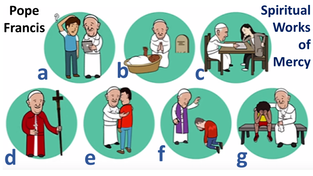
Please look at the illustrations of Pope Francis and his Spiritual Works of Mercy. Write the letter that stands next to each illustration and write what work of mercy it is.
You can do this assignment in English or in Spanish or you can mix both languages.
- Write 4 Spiritual Works of Mercy that you received from someone this week.
- Write 4 Spiritual Works of Mercy that you would like to do this week.
Ask an adult in your home to read it and approve it (agree with it). Write the name of the adult who approved it in this way:
Approved by…(name of the adult)…
Or
Aprobado por / Aceptado por…(name of the adult)…
Please complete the Quizzlet assignments about the Corporal Acts of Mercy.
4.29.20 Assignment
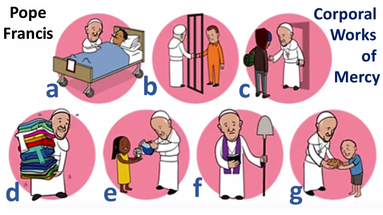
Please look at the illustrations of Pope Francis and his Corporal Works of Mercy. Write the letter that stands next to each illustration and write what work of mercy it is.
Question:
What is the connection between this lesson and the lesson on Mt 25: 31?
A True/False question is marked as T/F and a number. If your answer is “False”, please add the correct response, e.g.:
T/F3: False. + …your answer.
If your answer is “True”, just write a T.
T/F1: I can clothe the naked by helping my little sister tie her shoes.
T/F2: Jesus wants me to invite homeless people into my home.
T/F3: “corporal” comes from Latin corpus which means body.
T/F4: Jesus wants me to work at the cemetery.
You can do this assignment in English or in Spanish or you can mix both languages.
Write the list of the 7 Corporal Works of Mercy and to each of them add one example of how you are going to put them into practice this week. Ask an adult in your home to read it and approve it (agree with it).
Write the name of the adult who approved it in this way:
Question:
What is the connection between this lesson and the lesson on Mt 25: 31?
A True/False question is marked as T/F and a number. If your answer is “False”, please add the correct response, e.g.:
T/F3: False. + …your answer.
If your answer is “True”, just write a T.
T/F1: I can clothe the naked by helping my little sister tie her shoes.
T/F2: Jesus wants me to invite homeless people into my home.
T/F3: “corporal” comes from Latin corpus which means body.
T/F4: Jesus wants me to work at the cemetery.
You can do this assignment in English or in Spanish or you can mix both languages.
Write the list of the 7 Corporal Works of Mercy and to each of them add one example of how you are going to put them into practice this week. Ask an adult in your home to read it and approve it (agree with it).
Write the name of the adult who approved it in this way:
- Approved by…(name of the adult)…
- Aprobado por / Aceptado por…(name of the adult)…
4.22.20 Assignment

TRUE/FALSE:
T/F1: Jesus says that everybody will come to heaven.
T/F2: Jesus says that those who pay a lot of money will get to heaven.
T/F3: Even my little brother can be that little brother about which Jesus speaks.
T/F4: Some adult people can be my little brothers or sisters.
T/F5: The good people in the story where surprised when Jesus tells them that they fed Him.
Questions:
1. Where in the Bible do we find the story about the Final Judgment (the story we just heard in the video)?
2. Why do good people come to heaven?
3. Who are the little brothers and sisters of Jesus?
4. Why don’t bad people come to heaven?
5. Who is a little brother or sister of Jesus in your life?
6. Tell the story to another person. What did that person notice about the story that you did not think about?
4.15.20 Assignment
Introduction
Please read the stories from the Bible (the Gospel of John). After each story reply to the questions. Each of your answers should start with the number of the question, e.g.:
Q4: …your answer.
A True/False question is marked as T/F and the question number.
If your answer is “False”, please add the correct response, e.g.:
T/F 4: False. + …why you answered false.
If your answer is “True”, just write a T4 (as an example.)
Before you read John 20.
Mary Magdalene or Mary of Magdala is a very good friend of Jesus. Jesus died on Friday. Starting Friday night + the whole Saturday Jewish people are not allowed to work. Preparing a body for the burial takes a lot of work. Mary started that work on Friday afternoon, then rested all Saturday. Sunday morning she planned on continuing her work.
Sunday is the first day of the week in the Jewish calendar. It is a workday.
Saturday is a holiday in the Jewish calendar. Jewish people rest on Saturdays just like God rested on the seventh day in Genesis 1.
Simon Peter is a very good friend of Jesus and the head of the 12 Apostles.
An Apostle is a close collaborator of Jesus, handpicked by Jesus Himself.
A disciple (de – SI – pel ) is a person who admires Jesus and becomes His student and follower.
“the other disiciple” is John. He speaks that way about himself. He hopes that if he calls himself that way people will pay more attention to Jesus (who is very important) than to John.
John is the youngest Apostle and a very close friend of Jesus. John wrote the Gospel of John. The stories below are events that he experienced himself.
Aramaic is the language that Jesus spoke with his family and friends.
Hebrew is the language in which the Old Testament in the Bible was written. Jewish people first spoke Hebrew, but after hundreds of years they switched to Aramaic. The two languages are similar.
to ascend ( a – SEND ) means to go up or to rise through the air.
Rabbi or Rabboni means “teacher” or “master” in Hebrew and Aramaic.
Please answer:
T/F 1: On Sundays Jewish people do not work.
T/F 2: John is the author of the Gospel that contains the events described below.
T/F 3: Hebrew or Aramaic - it is the same.
T/F 4: A disciple means a student or follower.
T/F 5: Rabbi or Rabboni means God.
Introduction
Please read the stories from the Bible (the Gospel of John). After each story reply to the questions. Each of your answers should start with the number of the question, e.g.:
Q4: …your answer.
A True/False question is marked as T/F and the question number.
If your answer is “False”, please add the correct response, e.g.:
T/F 4: False. + …why you answered false.
If your answer is “True”, just write a T4 (as an example.)
Before you read John 20.
Mary Magdalene or Mary of Magdala is a very good friend of Jesus. Jesus died on Friday. Starting Friday night + the whole Saturday Jewish people are not allowed to work. Preparing a body for the burial takes a lot of work. Mary started that work on Friday afternoon, then rested all Saturday. Sunday morning she planned on continuing her work.
Sunday is the first day of the week in the Jewish calendar. It is a workday.
Saturday is a holiday in the Jewish calendar. Jewish people rest on Saturdays just like God rested on the seventh day in Genesis 1.
Simon Peter is a very good friend of Jesus and the head of the 12 Apostles.
An Apostle is a close collaborator of Jesus, handpicked by Jesus Himself.
A disciple (de – SI – pel ) is a person who admires Jesus and becomes His student and follower.
“the other disiciple” is John. He speaks that way about himself. He hopes that if he calls himself that way people will pay more attention to Jesus (who is very important) than to John.
John is the youngest Apostle and a very close friend of Jesus. John wrote the Gospel of John. The stories below are events that he experienced himself.
Aramaic is the language that Jesus spoke with his family and friends.
Hebrew is the language in which the Old Testament in the Bible was written. Jewish people first spoke Hebrew, but after hundreds of years they switched to Aramaic. The two languages are similar.
to ascend ( a – SEND ) means to go up or to rise through the air.
Rabbi or Rabboni means “teacher” or “master” in Hebrew and Aramaic.
Please answer:
T/F 1: On Sundays Jewish people do not work.
T/F 2: John is the author of the Gospel that contains the events described below.
T/F 3: Hebrew or Aramaic - it is the same.
T/F 4: A disciple means a student or follower.
T/F 5: Rabbi or Rabboni means God.
The Gospel of John chapter 20
The Empty Tomb
Early on the first day of the week, while it was still dark, Mary Magdalene went to the tomb and saw that the stone had been removed from the entrance. 2 So she came running to Simon Peter and the other disciple, the one Jesus loved, and said, “They have taken the Lord out of the tomb, and we don’t know where they have put him!”
3 So Peter and the other disciple started for the tomb. 4 Both were running, but the other disciple outran Peter and reached the tomb first. 5 He bent over and looked in at the strips of linen lying there but did not go in. 6 Then Simon Peter came along behind him and went straight into the tomb. He saw the strips of linen lying there, 7 as well as the cloth that had been wrapped around Jesus’ head. The cloth was still lying in its place, separate from the linen. 8 Finally the other disciple, who had reached the tomb first, also went inside. He saw and believed. 9 (They still did not understand from Scripture that Jesus had to rise from the dead.) 10 Then the disciples went back to where they were staying.
Please answer:
Q1: What did Mary Magdalene actually see with her own eyes?
Q2: What did she tell the disciples?
Q3: What did Peter see in the tomb?
T/F6: Peter ran faster than John because he was older.
T/F7: John was the only close friend of Jesus who immediately believed that Jesus rose from the dead and is alive again.
The Empty Tomb
Early on the first day of the week, while it was still dark, Mary Magdalene went to the tomb and saw that the stone had been removed from the entrance. 2 So she came running to Simon Peter and the other disciple, the one Jesus loved, and said, “They have taken the Lord out of the tomb, and we don’t know where they have put him!”
3 So Peter and the other disciple started for the tomb. 4 Both were running, but the other disciple outran Peter and reached the tomb first. 5 He bent over and looked in at the strips of linen lying there but did not go in. 6 Then Simon Peter came along behind him and went straight into the tomb. He saw the strips of linen lying there, 7 as well as the cloth that had been wrapped around Jesus’ head. The cloth was still lying in its place, separate from the linen. 8 Finally the other disciple, who had reached the tomb first, also went inside. He saw and believed. 9 (They still did not understand from Scripture that Jesus had to rise from the dead.) 10 Then the disciples went back to where they were staying.
Please answer:
Q1: What did Mary Magdalene actually see with her own eyes?
Q2: What did she tell the disciples?
Q3: What did Peter see in the tomb?
T/F6: Peter ran faster than John because he was older.
T/F7: John was the only close friend of Jesus who immediately believed that Jesus rose from the dead and is alive again.
Jesus Appears to Mary Magdalene
11 Now Mary stood outside the tomb crying. As she wept, she bent over to look into the tomb 12 and saw two angels in white, seated where Jesus’ body had been, one at the head and the other at the foot.
13 They asked her, “Woman, why are you crying?”
“They have taken my Lord away,” she said, “and I don’t know where they have put him.” 14 At this, she turned around and saw Jesus standing there, but she did not realize that it was Jesus.
15 He asked her, “Woman, why are you crying? Who is it you are looking for?”
Thinking he was the gardener, she said, “Sir, if you have carried him away, tell me where you have put him, and I will get him.”
16 Jesus said to her, “Mary.”
She turned toward him and cried out in Aramaic, “Rabboni!” (which means “Teacher”).
17 Jesus said, “Do not hold on to me, for I have not yet ascended to the Father. Go instead to my brothers and tell them, ‘I am ascending to my Father and your Father, to my God and your God.’”
18 Mary Magdalene went to the disciples with the news: “I have seen the Lord!” And she told them that he had said these things to her.
Please answer:
Q4: What does the word “Rabboni” mean?
Q5: Why do you think Jesus asked Mary Magdalene not to hold on to him?
T/F8: Jesus and Mary Magdalene spoke Polish with each other.
T/F9: Mary Magdalene thought that Jesus was the gardener.
T/F10: Jesus asked Mary Magdalene to keep their conversation a secret.
11 Now Mary stood outside the tomb crying. As she wept, she bent over to look into the tomb 12 and saw two angels in white, seated where Jesus’ body had been, one at the head and the other at the foot.
13 They asked her, “Woman, why are you crying?”
“They have taken my Lord away,” she said, “and I don’t know where they have put him.” 14 At this, she turned around and saw Jesus standing there, but she did not realize that it was Jesus.
15 He asked her, “Woman, why are you crying? Who is it you are looking for?”
Thinking he was the gardener, she said, “Sir, if you have carried him away, tell me where you have put him, and I will get him.”
16 Jesus said to her, “Mary.”
She turned toward him and cried out in Aramaic, “Rabboni!” (which means “Teacher”).
17 Jesus said, “Do not hold on to me, for I have not yet ascended to the Father. Go instead to my brothers and tell them, ‘I am ascending to my Father and your Father, to my God and your God.’”
18 Mary Magdalene went to the disciples with the news: “I have seen the Lord!” And she told them that he had said these things to her.
Please answer:
Q4: What does the word “Rabboni” mean?
Q5: Why do you think Jesus asked Mary Magdalene not to hold on to him?
T/F8: Jesus and Mary Magdalene spoke Polish with each other.
T/F9: Mary Magdalene thought that Jesus was the gardener.
T/F10: Jesus asked Mary Magdalene to keep their conversation a secret.
Jesus Appears to His Disciples
19 On the evening of that first day of the week, when the disciples were together, with the doors locked for fear of the Jewish leaders, Jesus came and stood among them and said, “Peace be with you!” 20 After he said this, he showed them his hands and side. The disciples were overjoyed when they saw the Lord.
21 Again Jesus said, “Peace be with you! As the Father has sent me, I am sending you.” 22 And with that he breathed on them and said, “Receive the Holy Spirit. 23 If you forgive anyone’s sins, their sins are forgiven; if you do not forgive them, they are not forgiven.”
Please answer:
Q6: What could Jesus body do after He came to life again? Hint: door
Q7: Why did Jesus show his hands and side to the disciples?
Q8: How did Jesus greet the disciples?
Q9: When do we use this greeting today?
19 On the evening of that first day of the week, when the disciples were together, with the doors locked for fear of the Jewish leaders, Jesus came and stood among them and said, “Peace be with you!” 20 After he said this, he showed them his hands and side. The disciples were overjoyed when they saw the Lord.
21 Again Jesus said, “Peace be with you! As the Father has sent me, I am sending you.” 22 And with that he breathed on them and said, “Receive the Holy Spirit. 23 If you forgive anyone’s sins, their sins are forgiven; if you do not forgive them, they are not forgiven.”
Please answer:
Q6: What could Jesus body do after He came to life again? Hint: door
Q7: Why did Jesus show his hands and side to the disciples?
Q8: How did Jesus greet the disciples?
Q9: When do we use this greeting today?
Jesus Appears to Thomas
24 Now Thomas, one of the Twelve, was not with the disciples when Jesus came. 25 So the other disciples told him, “We have seen the Lord!”
But he said to them, “Unless I see the nail marks in his hands and put my finger where the nails were, and put my hand into his side, I will not believe.”
26 A week later his disciples were in the house again, and Thomas was with them. Though the doors were locked, Jesus came and stood among them and said, “Peace be with you!” 27 Then he said to Thomas, “Put your finger here; see my hands. Reach out your hand and put it into my side. Stop doubting and believe.”
28 Thomas said to him, “My Lord and my God!”
29 Then Jesus told him, “Because you have seen me, you have believed; blessed are those who have not seen and yet have believed.”
Please answer:
Q10: What do you think Jesus means when he says: “blessed are those who have not seen and yet have believed”
T/F11: Thomas wanted to put his finger in Jesus’ eye.
T/F12: After he became alive again, Jesus could walk through locked doors.
T/F13: Jesus got very mad at Thomas and did not want to see him.
T/F14: After touching Jesus, Thomas believed that He was God.
24 Now Thomas, one of the Twelve, was not with the disciples when Jesus came. 25 So the other disciples told him, “We have seen the Lord!”
But he said to them, “Unless I see the nail marks in his hands and put my finger where the nails were, and put my hand into his side, I will not believe.”
26 A week later his disciples were in the house again, and Thomas was with them. Though the doors were locked, Jesus came and stood among them and said, “Peace be with you!” 27 Then he said to Thomas, “Put your finger here; see my hands. Reach out your hand and put it into my side. Stop doubting and believe.”
28 Thomas said to him, “My Lord and my God!”
29 Then Jesus told him, “Because you have seen me, you have believed; blessed are those who have not seen and yet have believed.”
Please answer:
Q10: What do you think Jesus means when he says: “blessed are those who have not seen and yet have believed”
T/F11: Thomas wanted to put his finger in Jesus’ eye.
T/F12: After he became alive again, Jesus could walk through locked doors.
T/F13: Jesus got very mad at Thomas and did not want to see him.
T/F14: After touching Jesus, Thomas believed that He was God.
Stations of the Cross
Station of the Cross for children – tasks
Prepare a pen and paper. Review the tasks for the Stations (below).
Click on Station 1. Once you are done listening, choose two tasks out of four.
Repeat the steps after each station until you complete Station 15.
Tasks for Stations of the Cross:
1. What two physical objects can represent the Station? (except the cross)
2. How can a person my age experience a similar situation?
3. How can we hurt Jesus in a similar situation?
4. Write a personal prayer in response to the Station. Include: “I’m sorry..., Thank you…, Please…”
Prayer that all pray after each Station:
Father: We adore You, O Christ, and we praise You
We: Because by Your holy cross You have redeemed the world.
Prepare a pen and paper. Review the tasks for the Stations (below).
Click on Station 1. Once you are done listening, choose two tasks out of four.
Repeat the steps after each station until you complete Station 15.
Tasks for Stations of the Cross:
1. What two physical objects can represent the Station? (except the cross)
2. How can a person my age experience a similar situation?
3. How can we hurt Jesus in a similar situation?
4. Write a personal prayer in response to the Station. Include: “I’m sorry..., Thank you…, Please…”
Prayer that all pray after each Station:
Father: We adore You, O Christ, and we praise You
We: Because by Your holy cross You have redeemed the world.
Select the button below the picture of the Station of the Cross to hear Fr. Pawel's Audio teaching on the station.
You will need to download the audio file. When prompted, select Window's Media Player as the option listen.
You will need to download the audio file. When prompted, select Window's Media Player as the option listen.
March 25, 2020 St. Luke Church Phoenix, AZ
Questions for RE elementary years 1, 2, and 3
With your parents watch the videos posted on our parish website under Fr. Pawel’s Daily Message.
You can choose either UPDATE 1 – 6 or NOTICIAS 1 – 6.
Answer the following questions. You can answer in English or in Spanish.
UPDATE / NOTICIAS 1
Q.1: What does our parish St. Luke offer to parishioners during the pandemic?
UPDATE / NOTICIAS 2
Q.2: The video discusses different ways how you can prepare yourself for a confession. Name two of them.
UPDATE / NOTICIAS 3
Q.3: How can I pray in my own words before the Spiritual Communion?
UPDATE / NOTICIAS 4
Q.4: According to the video, how can we create an appropriate time and space to pray while there are no Masses in church?
UPDATE / NOTICIAS 5
Q.5: According to the video, what can we do to help others during the coronavirus pandemic?
UPDATE / NOTICIAS 6
Q.6: According to the video, what was Mary doing as the angel Gabriel appeared to her?
Questions for RE elementary years 1, 2, and 3
With your parents watch the videos posted on our parish website under Fr. Pawel’s Daily Message.
You can choose either UPDATE 1 – 6 or NOTICIAS 1 – 6.
Answer the following questions. You can answer in English or in Spanish.
UPDATE / NOTICIAS 1
Q.1: What does our parish St. Luke offer to parishioners during the pandemic?
UPDATE / NOTICIAS 2
Q.2: The video discusses different ways how you can prepare yourself for a confession. Name two of them.
UPDATE / NOTICIAS 3
Q.3: How can I pray in my own words before the Spiritual Communion?
UPDATE / NOTICIAS 4
Q.4: According to the video, how can we create an appropriate time and space to pray while there are no Masses in church?
UPDATE / NOTICIAS 5
Q.5: According to the video, what can we do to help others during the coronavirus pandemic?
UPDATE / NOTICIAS 6
Q.6: According to the video, what was Mary doing as the angel Gabriel appeared to her?


